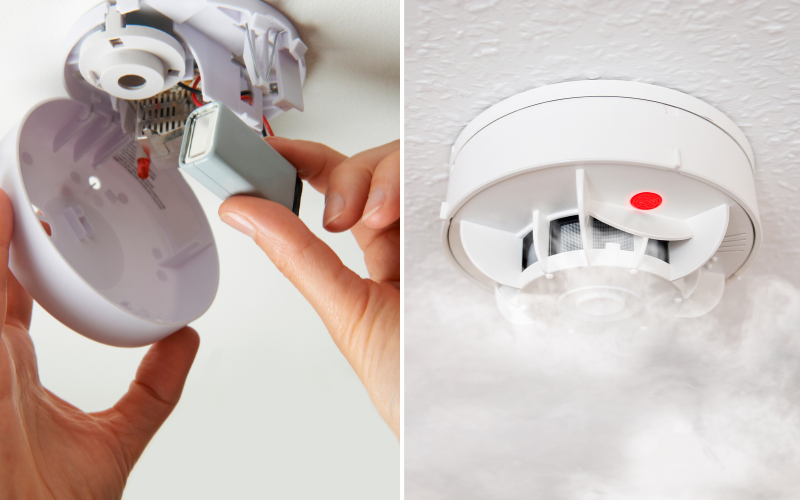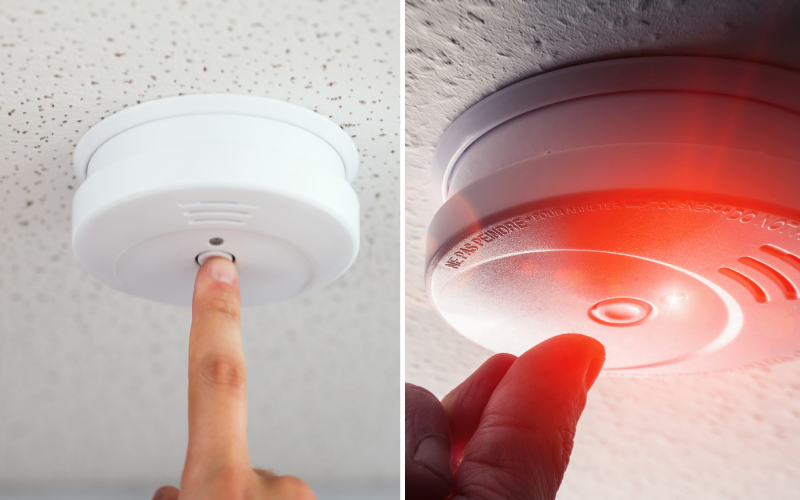If you’re asking ‘can you still buy battery operated smoke alarms,’ the answer is a resounding yes. This guide provides a comprehensive look at these indispensable fire safety tools, detailing their continued relevance, easy installation, and what to consider when adding them to your home’s safety plan.
Key Takeaways
- Battery operated smoke alarms are widely available, offering easy installation and flexibility for placement without the need for professional installation or home wiring modifications.
- Smoke alarms come in different detection technologies, namely ionization for fast flaming fires and photoelectric for smoldering fires, with combination alarms also available for comprehensive detection.
- Regular maintenance, including battery replacement and testing, is crucial for optimum performance, and smoke detectors should be replaced every 10 years, in line with the recommendations of the National Fire Protection Association.
Availability of Battery Operated Smoke Alarms
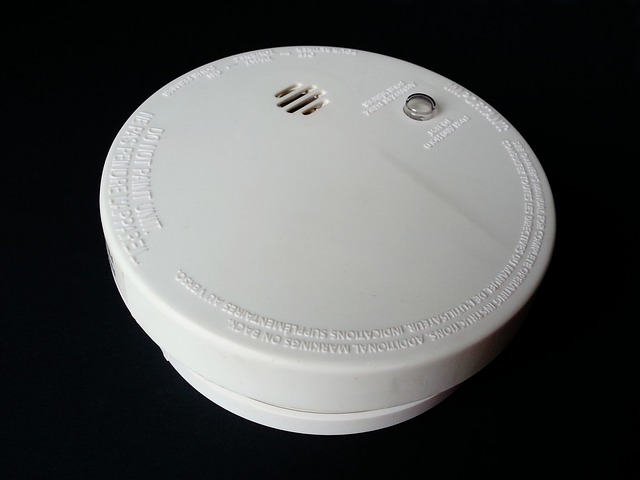
Picture the convenience of having a fire alarm system that can be installed anywhere in your home without the complications of wiring. That is the reality with battery operated smoke alarms, which are not only available but have become a mainstay in residential fire protection. These versatile alarms offer a range of installation options, from traditional wall and ceiling mounts to simply resting on a shelf or desk, catering to the needs of any living space.
For the DIY enthusiasts and those who prefer not to delve into the intricacies of home electrical systems, these battery powered smoke detectors are a boon. They eliminate the need for professional installation, meaning safety does not have to come with a hefty price tag or an appointment with an electrician. The self-sufficiency these devices offer makes them an attractive option for homeowners and renters alike.
Choosing Between Battery Operated and Hardwired Alarms
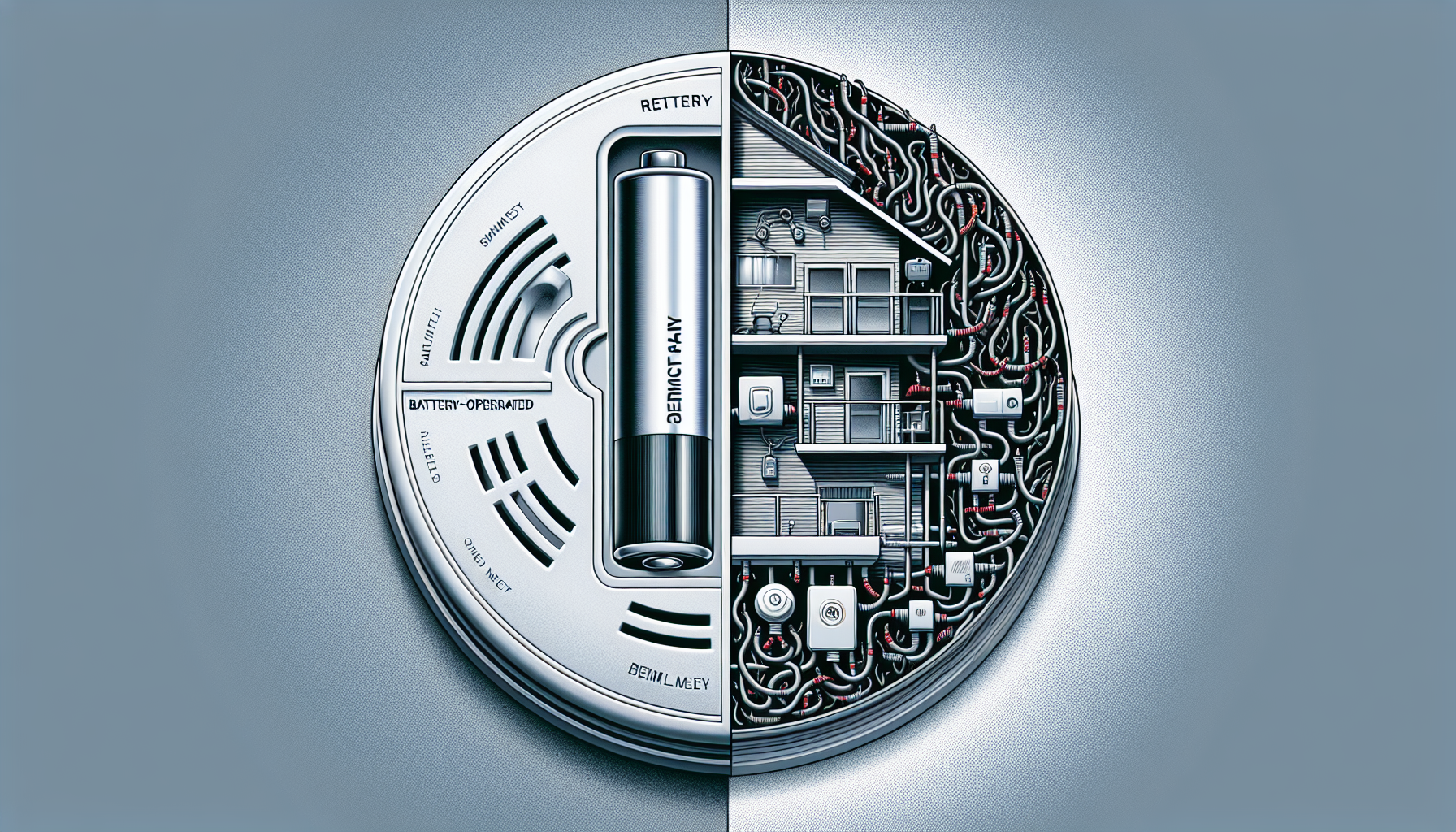
With an array of smoke alarms at your disposal, the decision between battery operated and hardwired alarms can be daunting. Each type has its own set of merits and considerations, from installation ease to power supply reliability.
The following segments will help you weigh these factors, ensuring you make an informed decision that aligns with your home safety goals and lifestyle preferences.
Installation Ease of Battery Powered Smoke Detectors
The installation of a battery-powered smoke alarm is a straightforward affair that can be completed with minimal tools and no need for an electrician. The simplicity of attaching a mounting base to your chosen spot, securing it with a few drills and screws, and then clicking the alarm into place is appealing to anyone who favors a quick and easy installation. This process is not only a time saver but also allows for the flexibility to place alarms in optimal locations throughout your home, without being constrained by existing wiring.
This ease of installation is a significant advantage, particularly for those in temporary housing or for whom making modifications to the electrical system is not an option. Battery powered smoke detectors can be installed, uninstalled, and reinstalled as needed, making them the ideal choice for renters or anyone in a transitional living situation.
Reliability of Power Supply in Fire Alarms
When it comes to reliability, hardwired smoke alarms hold a distinct advantage by being connected to your home’s AC power supply, complemented with a battery backup. This dual power source ensures that the fire alarm remains operational even during a power outage, a critical feature for continuous protection. However, this reliability hinges on the condition of the backup batteries, which need to be replaced at least every six months to maintain optimal performance.
This requirement for regular battery replacement in hardwired models may be seen as a minor inconvenience but is a small price to pay for the added peace of mind. It is a reminder that regardless of the type of smoke alarm system chosen, maintenance is key to ensuring that the unit functions correctly when it matters most.
Convenience and Accessibility of Battery Operated Smoke Alarms
Convenience is the hallmark of battery operated smoke alarms. Their independence from home wiring systems makes them a practical choice for many scenarios. Whether you’re securing a detached garage, an attic without easy electrical access, or an older home where rewiring is a challenge, these detectors are designed to function autonomously and can be quickly secured using a mounting bracket. This portability allows for strategic placement, ensuring that each area of your home is equipped with a reliable warning system against the threat of fire.
Furthermore, battery powered smoke alarms are an essential safety enhancement for properties that may lack the infrastructure for hardwired systems, such as historic homes or rental units. In such cases, the ability to easily install and maintain these detectors without structural changes is not only convenient but often the only viable fire safety solution when compared to other smoke alarms.
Types of Smoke Detection Technologies

The heart of any smoke alarm lies in its detection technology, which is the key to its responsiveness to fire. There are primarily two types of sensors used in smoke alarms: ionization and photoelectric, each with its own strengths in detecting different kinds of fires. Additionally, combination alarms that incorporate both technologies offer a comprehensive approach to fire detection, ensuring that no matter the type of fire, you are alerted as quickly as possible.
Ionization Alarms and Fast Flaming Fires
Ionization alarms are equipped with a small amount of radioactive material that ionizes air particles, which allows these units to be incredibly responsive to the smoke from fast flaming fires. These types of fires, often fed by flammable liquids, wood, or paper, produce high flames and comparatively less smoke, making the quick detection capabilities of ionization alarms particularly valuable.
The prevalence of materials in the home that can give rise to fast-flaming fires necessitates an alarm that can provide early warning, and ionization alarms fit the bill. By sounding the alert at the first hint of a fast-developing fire, these alarm sounds can be the difference between a close call and a catastrophic event, making them an essential part of a home’s fire safety strategy.
Photoelectric Alarms for Smoldering Fires
Conversely, photoelectric alarms excel at detecting the large smoke particles typical of smoldering fires, which are often characterized by a long, slow burn before flames appear. These alarms use a light source to sense the presence of smoke, providing a timely alert that can be crucial in allowing residents to escape from slow-burning fires that may not be immediately visible.
The addition of battery operated photoelectric smoke alarms to your fire safety arsenal is a wise choice, particularly since they offer flexible placement options and do not rely on hardwired power sources. This adaptability ensures that you can provide maximum protection in every area of your home, safeguarding against the insidious nature of smoldering fires.
Maintenance and Battery Life in Smoke Detectors
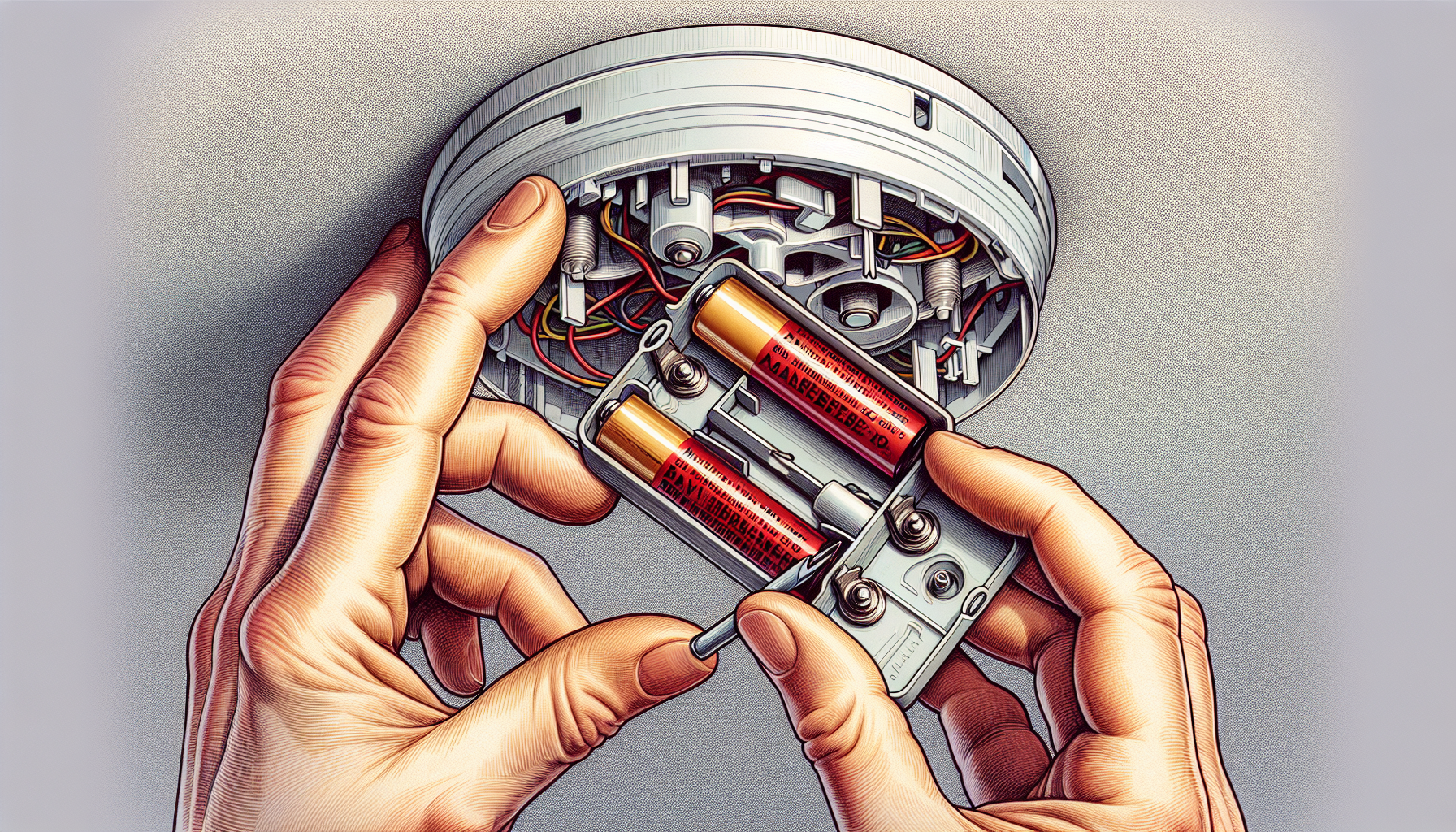
Maintaining smoke alarms is not just a matter of compliance; it is a fundamental aspect of ensuring your home’s safety. Battery life plays a pivotal role in the performance of smoke detectors, as a waning battery can result in a weakened alarm signal, potentially compromising your first line of defense against fire.
Thankfully, advancements in battery technology, such as the use of lithium-ion, 9V lithium, and rechargeable batteries, mean that battery power replacements are less frequent, with some batteries lasting as long as 10 years.
Low Battery Warning and Battery Replacement
The familiar chirp of a smoke detector’s low battery warning is designed to prompt action, signaling that it’s time to replace the battery. For standard nine-volt batteries, the recommendation is to replace them every six months, a practice easily remembered by syncing the task with the changes in Daylight Saving Time. However, for smoke detectors with non-replaceable 10-year lithium batteries, the entire unit must be replaced after a decade, as these batteries are designed to last for the alarm’s entire lifespan without the need for battery replacement.
It is essential to heed these low battery warnings and to replace batteries proactively, ideally before the chirp even begins. In doing so, it’s best to replace all the batteries in your smoke detectors at the same time to ensure uniform protection throughout your home. Regular battery replacement and attention to low battery warnings are small steps that can have a significant impact on the efficacy of your smoke alarms.
Lifespan of Smoke Detectors and When to Replace
Smoke detectors are not designed to last indefinitely. The National Fire Protection Association advises that most smoke detectors should be replaced every 10 years from the date of manufacture. This guideline is independent of the battery type, as the sensor’s sensitivity can degrade over time, reducing the detector’s effectiveness. If your smoke alarm continues to chirp after you’ve replaced the battery, it’s likely a sign that the device has reached the end of its life and needs to be replaced.
Adherence to this 10-year replacement rule is crucial for maintaining a high level of fire safety in your home. Ignoring it can result in a false sense of security, which is why it’s important to regularly monitor the installation dates of your alarms and plan for timely replacements.
Mitigating Nuisance Alarms in Battery Operated Devices
The frustration of a false alarm from a smoke detector can lead some to disable their devices, a decision that significantly compromises safety. To mitigate nuisance alarms, strategic placement of smoke detectors is key: keep them away from high-humidity areas like bathrooms and at least 10 feet from cooking appliances to prevent false triggers. Additionally, contemporary battery operated smoke alarms often come with user-friendly features such as easy-access battery compartments and a test/silence button, empowering users to swiftly verify functionality and silence unwarranted alarms.
Upgrading to newer models with advanced detection technologies can also decrease the occurrence of nuisance alarms. These advancements are crucial not only for minimizing interruptions but also for maintaining the integrity of your fire alarm system, ensuring that each alert is taken seriously.
The Role of Federal Housing Authority and Smoke Alarm Requirements
The importance of smoke alarms is underscored by the Federal Housing Administration (FHA), which mandates the inclusion of functioning smoke detectors in homes as part of the eligibility criteria for FHA loans. The FHA stipulates that homes under renovation must have smoke detectors in each sleeping area, as well as in adjacent hallways and on levels without bedrooms, to comply with Section 203(k) mortgage provisions. Moreover, during an FHA appraisal, smoke detectors are required to be properly placed, functioning correctly, and in accordance with local building and fire codes.
These regulations highlight the government’s commitment to fire safety and the critical role smoke alarms play in protecting lives and property. Homeowners seeking FHA loan approval must ensure their smoke alarm systems meet these standards, which serve as a benchmark for fire safety best practices.
How to Test and Ensure Your Smoke Alarm's Performance
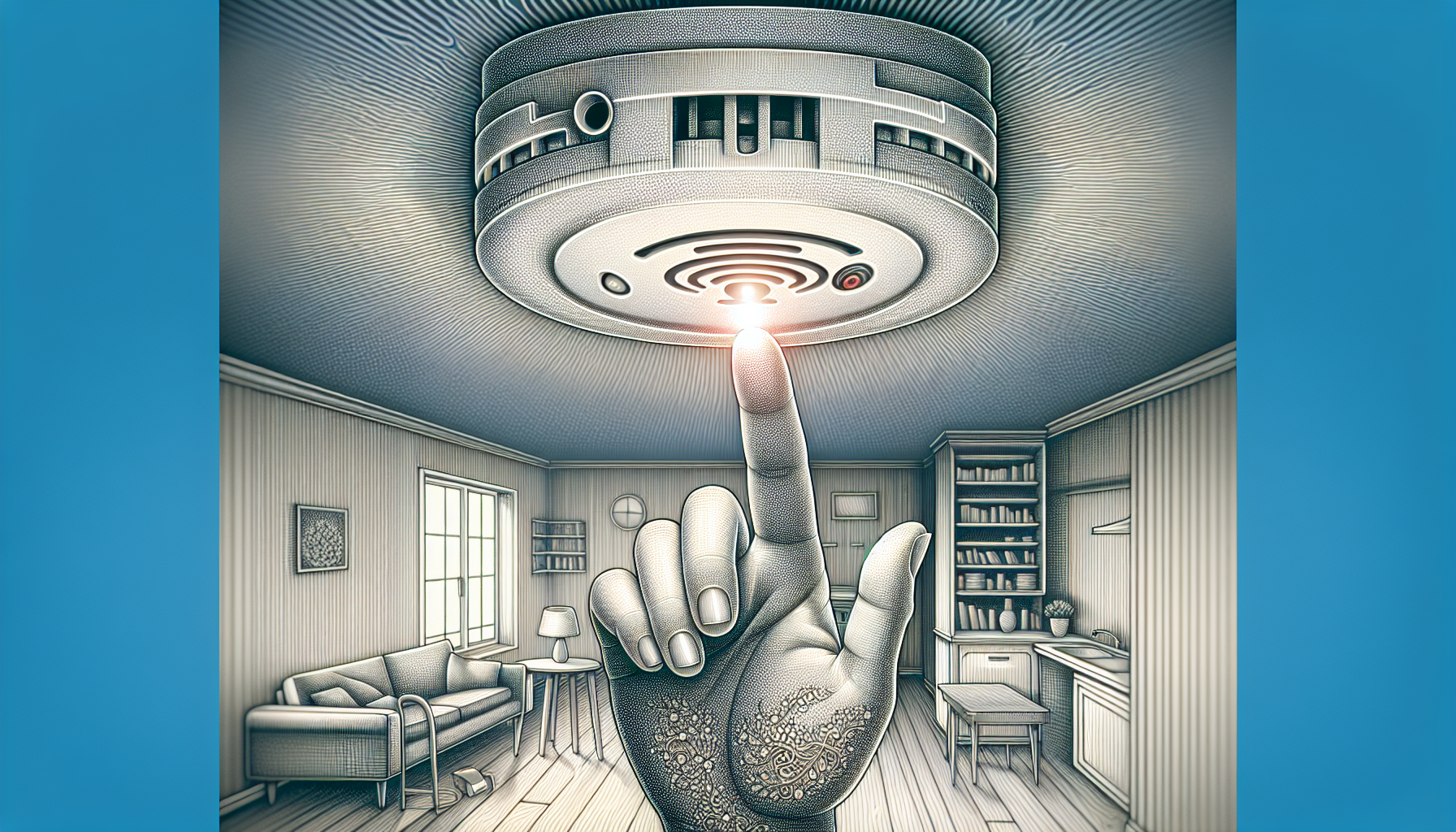
Ensuring the optimal performance of your smoke alarm is a simple yet vital routine that should be performed monthly. To test the alarm, press the test button and listen for the distinct triple-beep pattern that indicates everything is in working order. For example, the First Alert SA300CN3 battery-operated ionization smoke alarm features a test button, showcasing how user-friendly it can be to check your alarm’s functionality.
Regular testing of smoke alarms is an essential practice that provides assurance of their readiness to alert you in the event of a fire. By incorporating this simple check into your monthly home maintenance schedule, you can rest easy knowing your alarms are prepared to serve their purpose when called upon.
Summary
To sum up, smoke alarms are a non-negotiable aspect of home safety. From the convenience and flexibility of battery operated smoke alarms to the reassurance of hardwired systems with battery backup, there is a fire alarm solution tailored to every need and circumstance. Understanding the types of smoke detection technologies and the importance of regular maintenance can empower you to make informed decisions about your fire safety strategy. Remember, the right smoke alarm, properly maintained and tested, is your silent guardian, ready to alert you to danger and protect what matters most.
Frequently Asked Questions
Do battery operated smoke detectors meet code?
Yes, battery-operated smoke detectors must be powered by non-replaceable, non-removable 10-year batteries to comply with code regulations. This requirement applies to smoke alarms installed on or after January 1, 2022.
Are battery operated smoke alarms reliable?
Battery operated smoke alarms are reliable when properly maintained, offering the convenience of easy installation and flexibility in placement.
Can I have both ionization and photoelectric smoke alarms in my home?
Yes, you can have both ionization and photoelectric smoke alarms in your home to ensure comprehensive fire detection coverage. Combining these technologies provides added safety.
How do I know when to replace my smoke detector?
You should replace your smoke detector every 10 years from the manufacturing date or if it continues to chirp after replacing the battery, as it has likely reached the end of its lifespan.
What can I do to prevent nuisance alarms from my smoke detector?
To prevent nuisance alarms from your smoke detector, position them away from kitchens and bathrooms, regularly clean and maintain them, and consider upgrading to models with advanced technologies to reduce false alarms. Keeping these tips in mind can help prevent unnecessary disruptions and ensure reliable smoke detection in your home.
You Might Also Like...
